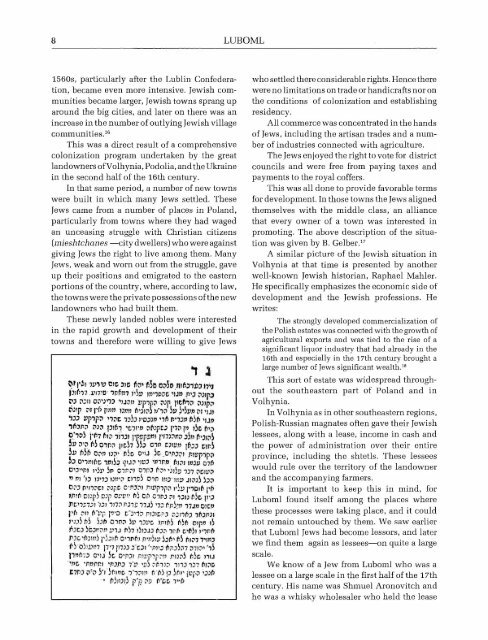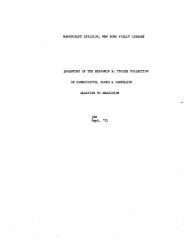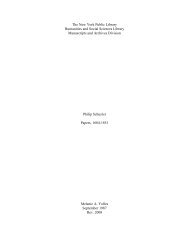pdf available - Multiple Choices
pdf available - Multiple Choices
pdf available - Multiple Choices
Create successful ePaper yourself
Turn your PDF publications into a flip-book with our unique Google optimized e-Paper software.
8 LUBOML<br />
1560s, particularly after the Lublin Confederation,<br />
became even more intensive. Jewish communities<br />
became larger, Jewish towns sprang up<br />
around the big cities, and later on there was an<br />
increase in the number of outlying Jewish village<br />
communities."<br />
This was a direct result of a comprehensive<br />
colonization program undertaken by the great<br />
landowners of Volhynia, Podolia, and the Ukraine<br />
in the second half of the 16th century.<br />
In that same period, a number of new towns<br />
were built in which many Jews settled. These<br />
Jews came from a number of places in Poland,<br />
particularly from towns where they had waged<br />
an unceasing struggle with Christian citizens<br />
(mieshtchanes city dwellers) who were against<br />
giving Jews the right to live among them. Many<br />
Jews, weak and worn out from the struggle, gave<br />
up their positions and emigrated to the eastern<br />
portions of the country, where, according to law,<br />
the towns were the private possessions of the new<br />
landowners who had built them.<br />
These newly landed nobles were interested<br />
in the rapid growth and development of their<br />
towns and therefore were willing to give Jews<br />
"r' )0 tv f.513 crr5D nif)xLt3 )71<br />
1'31(17 rl-ro irf 707 rS1.) innpric P,3<br />
CZ'';3 )_179) IT/R<br />
rb ¡Inn rT) 6,:»z+5 N,).<br />
1» vpljr., 1.".),'D.)711f) r-pn h5f) 'Un<br />
115)1,n Z1)71 pie, ,E.11,7) ;:,h)Tc.) 1,7;) )5c. fr:,<br />
0'17,5 i'07 11131 iTcper) l'rn7IrD 35» f:'.71;.5<br />
5v :I-, f5S onr7) pc57 55,D Cln if):) cIrS<br />
3D t)5f, ozm t5c o,I.3 5c C'n.7z1 rirplp,7)<br />
5.7 nnrn toN Jr:I) o7f)<br />
op"r1 51) clrri o7r) ((';'")63 1)7 nIr:,<br />
1)`7) ):Yro cr,c5 C/P Irl.) _DNS .5.'71<br />
CZ,J rrtl:T7 Z,J¡C Cn3:11 Pirrlrz,<br />
cr.TS c:r r); of) clro f' c<br />
3.'cp, 'pi 1177, rill:17.15 rT5',117.11, 01Cp<br />
1,6 1.,'D rin7.1 'afar»<br />
S3f) 07m-, 51, 1rlf'S f,6 olfm 75<br />
f"Jr3 SL.77712)1.) r,57 151)J) 07,1rf, c,t5) Ilpf)<br />
P./c,fp,7,5 Cr-)rhn,r571:51", f!5 TM)<br />
f'S 011,,,"7 17'7 1I7)) )'CJI r'PP.717..)577 771, '15<br />
pcfr)01.1 5r, o'r,), r».7,5 ('Sc r1r.1<br />
,rnrr) 'IPA) 7V 'E.) 7J7 151:1D<br />
r7r);1';) 5'; 5f,r,c -n-q, p 5f, ¡up v)f)<br />
f)51,315 Z,D<br />
I<br />
who settled there considerable rights. Hence there<br />
were no limitations on trade or handicrafts nor on<br />
the conditions of colonization and establishing<br />
residency.<br />
All commerce was concentrated in the hands<br />
of Jews, including the artisan trades and a number<br />
of industries connected with agriculture.<br />
The Jews enjoyed the right to vote for district<br />
councils and were free from paying taxes and<br />
payments to the royal coffers.<br />
This was all done to provide favorable terms<br />
for development. In those towns the Jews aligned<br />
themselves with the middle class, an alliance<br />
that every owner of a town was interested in<br />
promoting. The above description of the situation<br />
was given by B. Gelber."<br />
A similar picture of the Jewish situation in<br />
Volhynia at that time is presented by another<br />
well-known Jewish historian, Raphael Mahler.<br />
He specifically emphasizes the economic side of<br />
development and the Jewish professions. He<br />
writes:<br />
The strongly developed commercialization of<br />
the Polish estates was connected with the growth of<br />
agricultural exports and was tied to the rise of a<br />
significant liquor industry that had already in the<br />
16th and especially in the 17th century brought a<br />
large number of Jews significant wealth."<br />
This sort of estate was widespread throughout<br />
the southeastern part of Poland and in<br />
Volhynia.<br />
In Volhynia as in other southeastern regions,<br />
Polish-Russian magnates often gave their Jewish<br />
lessees, along with a lease, income in cash and<br />
the power of administration over their entire<br />
province, including the shtetls. These lessees<br />
would rule over the territory of the landowner<br />
and the accompanying farmers.<br />
It is important to keep this in mind, for<br />
Luboml found itself among the places where<br />
these processes were taking place, and it could<br />
not remain untouched by them. We saw earlier<br />
that Luboml Jews had become lessors, and later<br />
we find them again as lesseeson quite a large<br />
scale.<br />
We know of a Jew from Luboml who was a<br />
lessee on a large scale in the first half of the 17th<br />
century. His name was Shmuel Aronovitch and<br />
he was a whisky wholesaler who held the lease







